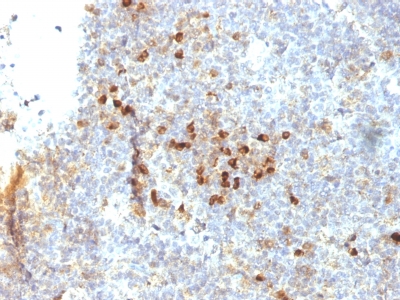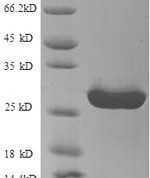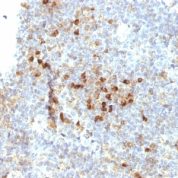Human Anti-HLA-DRA Antibody Product Attributes
Species: Human
Tested Applications: Flow Cytometry, Immunofluorescence, Immunohistochemistry (IHC).
Application Notes: Flow Cytometry (0.5-1ug of antibody/million cells in 0.1ml), Immunofluorescence (0.5-1ug of antibody/ml), Immunohistochemistry (IHC) (Formalin-fixed) (1-2ug of antibody/ml for 30 minutes at RT)
Clonality: Monoclonal
Anti-HLA-DRA Antibody Clone: 19-26.1; same as MB-26.1
Clone 19-26.1; same as MB-26.1 Host and Isotype: Mouse IgG2a kappa
Anti-Human HLA-DRA Positive Control Sample: Ramos, Daudi or HuT78 cells. Tonsil or lymph node
Cellular Localization of Antibody <19-26.1; same as MB-26.1 Staining: Cell surface
Buffer and Stabilizer: 10mM PBS with 0.05% BSA & 0.05% azide.
Antibody Concentration: 200ug/ml
Antibody Purification Method:Protein A/G Purified
Immunogen: Raji Cells
Storage Conditions: Store at 2 to 8° C (refrigerate). Stable for 24 months when properly stored.
HLA-DRA Previously Observed Antibody Staining Patterns
Observed Antibody Staining Data By Tissue Type:
Variations in HLA-DRA antibody staining intensity in immunohistochemistry on tissue sections are present across different anatomical locations. An intense signal was observed in cells in the glomeruli in kidney, germinal center cells in the lymph node and tonsil, glandular cells in the duodenum and endometrium, Langerhans in skin, lymphoid tissue in appendix, macrophages in lung, myoepithelial cells in the breast and non-germinal center cells in the lymph node and tonsil. More moderate antibody staining intensity was present in cells in the glomeruli in kidney, germinal center cells in the lymph node and tonsil, glandular cells in the duodenum and endometrium, Langerhans in skin, lymphoid tissue in appendix, macrophages in lung, myoepithelial cells in the breast and non-germinal center cells in the lymph node and tonsil. Low, but measureable presence of HLA-DRA could be seen in cells in the red pulp in spleen, cells in the tubules in kidney, endothelial cells in the colon, epidermal cells in the skin, glandular cells in the appendix, cervix, uterine, epididymis and fallopian tube, glial cells in the caudate nucleus and hippocampus, myocytes in skeletal muscle, peripheral nerve in mesenchymal tissue, squamous epithelial cells in the tonsil and vagina and urothelial cells in the urinary bladder. We were unable to detect HLA-DRA in other tissues. Disease states, inflammation, and other physiological changes can have a substantial impact on antibody staining patterns. These measurements were all taken in tissues deemed normal or from patients without known disease.Limitations and Warranty
enQuire Bio's HLA-DRA Anti-Human Monoclonal is available for Research Use Only. This antibody is guaranteed to work for a period of two years when properly stored.







There are no reviews yet.